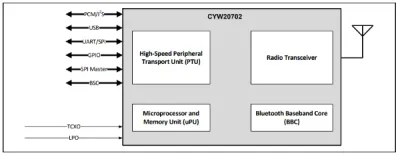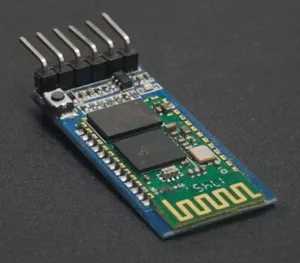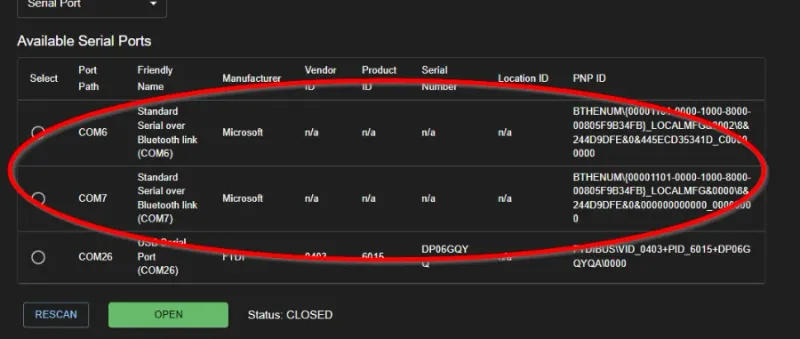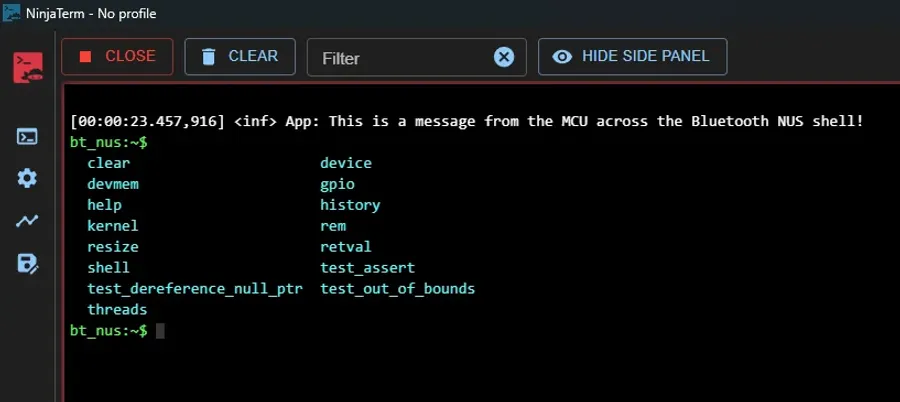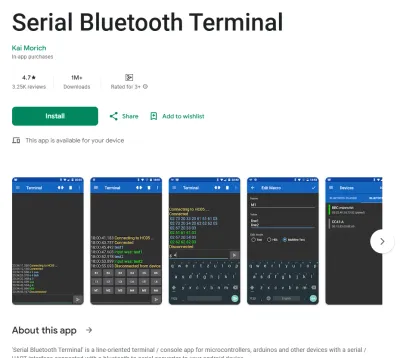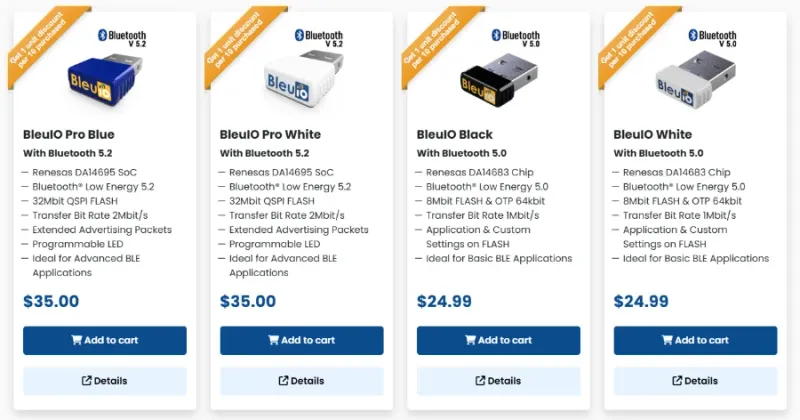Bluetooth
Bluetooth is a collection of short range wireless communication protocols. The Bluetooth Special Interests Group (SIG) was founded in 1998 and oversees the development of Bluetooth standards.1 The original Bluetooth is known as Bluetooth Classic and was designed as a short-range wireless point-to-point communications protocol.
Child Pages
Piconet And Scatternets
A Piconet is the term used for a small Bluetooth network with 1 master device connected to up to 7 active slave devices. Up to 255 more slave devices may be connected to the master but in a inactive or “parked” state. Active slaves can be parked to bring parked devices into the active state.3
Both active and parked slaves in a Piconet are time-synchronized to the master so that RF contention does not occur (they implement a Time Division Multiple Access (TDMA) network).
A Scatternet is two or more independent Piconets which are connected together by one node in one Piconet (either the master or a slave) also acting as a slave in the second Piconet.4
Advanced Audio Distribution Profile (A2DP)
This is a bluetooth standard which supports the streaming of audio between bluetooth-enabled devices.
Bluetooth 4.0
In 2010, the Bluetooth Core Specification version 4.0 was released. This included Bluetooth Low Energy (BLE), which is now more commonly known as Bluetooth Smart. Bluetooth Smart specifies a hub-and-spoke connection model (with broadcast support), but no mesh topology.
An attribute is a piece of labelled and addressable data. A characteristic is a group of attributes, and a service is a group of attributes.
attribute < characteristic < service
Bluetooth 4.0 uses the server/client paradigm.
L2CAP
L2CAP (Logical Link Control and Adaptation Protocol) is a protocol that provides connection-orientated and connectionless data services to the upper layer protocols. It sits above the HCI layer. It includes features such as multiplexing and data segmentation and reassembly (breaking data into smaller chunks and reassembling them at the other end).5 It is used by both Bluetooth Classic and Bluetooth Low Energy (BLE).
An L2CAP frame always contains a 4-byte header containing a 2-byte length and a 2-byte channel ID.6
Bluetooth Low Energy (BLE)
Bluetooth Low Energy (BLE) is a Bluetooth protocol specifically designed for communication on low power devices that need to run for months or years of small batteries. Active BLE connections can be maintained by a MCU with approx. 4-20uA of average current (depends on a lot of things, including connections settings and transmission power).
Channels
BLE has 40 channels, compared to Bluetooth Classic which has 79.7
Advertising
Advertising is when a BLE peripheral broadcasts packets to any device that wants to listen. Advertising allows a low energy device to sleep most of the time, only waking up periodically for a short amount of time to send a new advertisement packet. Advertising is unidirectional, the peripheral sends out unsolicited data and expects no response. To achieve 2-way communication you have to connect with the BLE peripheral.
Legacy advertising uses three channels from the 2.4GHz radio band, channels 37, 38 and 39. Extended advertising was added in Bluetooth 5.0 and uses all 40 Bluetooth LE channels, resulting in less collisions.8
Advertisement packets give you 31 bytes of data for application specific use.
When a phone or other connecting device sees advertisement packets from a BLE peripheral, it can request more information with a scan request. The phone send the device a scan request packet, the the device responds with a scan response packet. Both Android and iPhone devices automatically emit a scan request packet when they discover a new device as part of the Bluetooth scanning process7.
Connections
Connection settings:
- Connection interval (min): 7.5ms to 4s.9 Typically specified in units of 1.25ms.
- Connection interval (max): 7.5ms to 4s. Typically specified in units of 1.25ms.
- Latency: This is the latency of the peripheral. It allows the peripheral to skip N connection intervals if it doesn’t have any data to send(i.e. not respond).9 The Central device must still poll the peripheral on every connection interval. This has a similar power saving effect as reducing the connection interval, except with the added benefit that fast connection intervals can be used when the Peripheral has data to send.
- Timeout: If no packets have been received in this time, the connection is considered lost.
These connection settings are controlled by the Central device. However, the Peripheral can suggest connection parameters to the Central device. The Central device can choose to accept or reject them (or use different parameters). This is the reason a min. and a max. are given for the connection interval, it allows the peripheral to suggest a range and gives the Central device some flexibility in choosing the connection parameters.
See the Bluetooth section on the Zephyr page for information on how to set these connection parameters on MCUs running the Zephyr RTOS.
Beacons
Beacons are BLE peripherals that use advertisement exclusively, and do not allow for connections. This is so that the device can always be found and used, if a connection occurs then the peripheral is meant to stop advertising.7
Apple’s iBeacon is the most popular beacon standard.
LE Coded PHY
Bluetooth Low Energy was originally designed to reduce power consumption but offer the same transmission distances as standard Bluetooth (Bluetooth Classic). This is typically around 10-100m range in normal operation conditions (inside a building), and about 50-300m line of sight in optimal conditions. LE Coded PHY (a.k.a. Bluetooth long-range mode) was introduced in Bluetooth 5.0 to extend the range of Bluetooth Low Energy devices to approximately 4x the range of the 1M PHY.10
Support for LE Coded PHY is optional, and is not supported by all devices.10
With the addition of LE Coded PHY, there are now 3 PHYs available for BLE:
- LE 1M PHY: 1 Megasymbols per second. The original BLE PHY introduced in Bluetooth v4.0.
- LE 2M PHY: 2 Megasymbols per second. Introduced in Bluetooth 5.0, doubles the speed of the 1M PHY (approx.). Range is reduce to about 80% of the 1M PHY.11 The faster transmission speed was somewhat motivated by the desire to support firmware OTA updates.8
- LE Coded PHY: 1 Megasymbols per second, but with multiple symbols per bit. Introduced in Bluetooth 5.0, extends the range of Bluetooth Low Energy devices to 1km line of sight.
For the LE Coded PHY, data is still sent at 1 Megasymbols per second like in 1M PHY. The key difference is that is uses forward error correction (FEC), and multiple symbols are sent per bit, which gives increases transmission distance at the expense of slower data rates. This redundant information allows the receiver to detect and correct errors in the received data. There are two configurations for LE Coded PHY:
- S2: 2 symbols per bit in the payload. Gives a data rate of 500kbps.
- S8: 8 symbols per bit in the payload. Gives a data rate of 125kbps.
8 symbols per bit (S8) is always used for the access header, irrespective of the configuration for the payload.
In many applications, slowing down the transmission speed for increased range is a good trade-off. One downside to consider is the increased power usage. Power usage is approximately proportional to the radio on time, and you’ll spend approx. 8 times longer (this ignores things like start-up time) to send a packet with the LE Coded PHY S8 configuration than the standard 1M PHY. Thus 8 times more power is used.
Smartphone Support
LE Coded PHY support is optional, and as of August 2025 support on smartphones is somewhat common (support is getting better and better as time goes on).10
Information on the internet reports the following phones support LE Coded PHY:
- Google Pixel 4 (but device needs to advertise on LE 1M to be found first, so useless for long range applications!)13
- OnePlus 7 and above13
- Samsung Galaxy A813
- Samsung Galaxy Tab A713
- Samsung S10+13
- Samsung S2013
- Xiaomi Poco X313
Bluetooth Smart Mesh Working Group
In 2017, a set of three specifications were released by the Bluetooth SIG:
- Mesh Profile
- Mesh Model
- Mesh Device Properties
These specifications allowed Bluetooth devices to form a mesh network. Mesh Profiles use Bluetooth LE for it’s underlying radio communications, and as such Mesh Profiles work with Bluetooth 4.2 and Bluetooth 5 devices.
Bluetooth Mesh data packets can be up to 384 bytes.
Packet Delivery
Packets are not routed in a Bluetooth mesh, but instead use flooding. Packets are not sent through a particular sequence of nodes to reach the destination, nor are routing tables kept by any of the nodes. Instead, nodes can be designated as relays receive the message and re-broadcast it to everyone in range. Any relays receiving this will then re-broadcast it again, and so on. Nodes keep track of the packet ID so that they do not re-transmit a message they have already received and transmitted before. This method of flooding is intended to keep the network simple and resilient to node failure. If nodes acted as routers, their failure might have a significant impact on the network.14
Latencies
Bluetooth mesh latency depends on the payload size, number of nodes (incl. number of relays) and the connection topology. You can expect round-trip latencies of around 50ms for packets with an 8 byte payload that go through 3 hops15. Silicon Labs has a great application note, AN1137: Bluetooth Mesh Network Performance which goes into mesh latencies in more detail.
Encryption
Two types of encryption keys:
- Network keys: Specific to a physical network.
- Application keys: Specific to the function of the data, e.g. reading sensor values vs. configuring the sensor.
Bridge ICs
CH9141/CH9143
The CH9141 is a serial-to-Bluetooth BLE bridge IC made by Nanjing Qinheng Microelectronics Co., Ltd. that allows for “transparent” serial communication over Bluetooth. It supports broadcast, host and slave mode.16 It looks like there are not many suppliers for this IC, and much of the information is not in English.
Chipsets
Bluetooth chipsets are ICs that contain a Bluetooth transceiver and processor that are designed to be used in things such as Bluetooth USB dongles.
Broadcom BCM20702
The BCM20702 is a Bluetooth 4.0 processor made by Broadcom that is commonly found in Bluetooth USB dongles. Sometime on or before 2016, Cypress Semiconductor acquired the part number/IP and renamed it the CYW20702. There is not much information online about the original Broadcom BCM20702, but there is a datasheet for the Cypress part.
This is a placeholder for the reference: fig-cyw20702-internal-block-diagram shows the internal block diagram of the CYW20702 IC.
CSR8510
The CSR8510 is a Bluetooth 4.0 single-chip radio and baseband IC designed for PCs and other devices. It was originally designed by CSR (Cambridge Silicon Radio). CSR was acquired by Qualcomm in 2015.18 Qualcomm has kept the CSR part numbers. It appears the popular TP-Link UB400 Bluetooth dongle uses this chipset.19
Modules
HC-05/HC-06
The HC-05 and HC-06 are Bluetooth modules that are popular in the hobbyist space (e.g. commonly used with Arduinos). The are serial to Bluetooth modules which use the Bluetooth Classic SPP over RFCOMM protocol. The HC-05 is based of the CSR BC417143 IC.20
Serial Ports over Bluetooth
Traditionally, Bluetooth provides specific ways of accessing data in the form of profiles.There are two primary ways to provide a “serial port” over Bluetooth:
- SPP over RFCOMM on Bluetooth Classic: Bluetooth Classic defines a emulated serial port standard called the SPP (Serial Port Profile) which uses RFCOMM. It emulates not just a TX and RX serial stream, but also the flow control lines as defined by the RS-232 standard. See below for more details.
- BLE: The BLE specification does not define a serial port standard, but there are many proprietary implementations available. See below for more details.
SPP over RFCOMM
Bluetooth Classic defines a emulated serial port standard called the SPP (Serial Port Profile) which uses RFCOMM. RFCOMM in turn uses L2CAP. It emulates not just a TX and RX serial data lines (as streams), but also the flow control lines.22 It has good support by many Bluetooth-enabled microcontrollers, dongles and operating systems.
| Pin | Circuit Name |
|---|---|
| 102 | Signal Common |
| 103 | Transmit Data (TD) |
| 104 | Received Data (RD) |
| 105 | Request to Send (RTS) |
| 106 | Clear to Send (CTS) |
| 107 | Data Set Ready (DSR) |
| 108 | Data Terminal Ready (DTR) |
| 109 | Data Carrier Detect (CD) |
| 125 | Ring Indicator (RI) |
This is a placeholder for the reference: fig-microsoft-standard-serial-over-bluetooth-link-ports-screenshot-in-ninjaterm shows how Bluetooth devices that support SPP over RFCOMM can show up in Microsoft Windows. This screenshot was taken in NinjaTerm.
The HC-05 and HC-06 Bluetooth modules which are popular in the hobbyist space use SPP over RFCOMM to implement the bi-directional data stream.
BLE Serial
Unfortunately, there is no standard specified by the Bluetooth SIG for implementing a virtual serial port over Bluetooth Low Energy (BLE). However, many vendors have implemented their own proprietary protocols for this, and the few of them have become somewhat “industry standard”. What this means is to pick a particular service UUID, and within that one characteristic UUID for TX data, and another characteristic UUID for RX data.
Hopefully, the device includes the service IDs in it’s advertisement packet. This way, a Bluetooth central device which is looking for serial capable peripherals can perform a Bluetooth scan and identify the compatible peripherals without having to connect to them.
One of the most popular implementations is the Nordic Semiconductor “Nordic UART Service” (NUS). The service and characteristic UUIDs are:23
- Service UUID:
6e400001-b5a3-f393-e0a9-e50e24dcca9e(16-bit offset:0x0001) - RX Characteristic UUID:
6e400002-b5a3-f393-e0a9-e50e24dcca9e(properties: “write”, “write without response”) - TX Characteristic UUID:
6e400003-b5a3-f393-e0a9-e50e24dcca9e(properties: “notify”)
The Microchip Transparent UART Service is a implementation by Microchip. It uses the following UUIDs:24
- Service UUID:
49535343-fe7d-4ae5-8fa9-9fafd205e455 - RX Characteristic UUID:
49535343-8841-43f4-a8d4-ecbe34729bb3(properties: “write”, “write without response”) - TX Characteristic UUID:
49535343-1e4d-4bd9-ba61-23c647249616(properties: “notify”, “write”, “write without response”)
Texas Instruments also has an implementation called the TI Serial Port Service (SPS). It uses the following UUIDs:25
- Service UUID:
f000c0e0-0451-4000-b000-00000000-0000 - Data Characteristic UUID:
f000c0e1-0451-4000-b000-00000000-0000(properties: “notify”, “write”) - Status Characteristic UUID:
f000c0e2-0451-4000-b000-00000000-0000 - Config Characteristic UUID:
f000c0e3-0451-4000-b000-00000000-0000
The TI SPS implementation is a little different from Nordics and Microchips in that there is a single data characteristic for both TX and RX data, and additional information is sent via the status and config characteristics. It is designed so that you can actually configure a real serial port (i.e. one needing settings like baud rate, parity, stop bits, e.t.c) on the BLE peripheral over BLE from a phone/computer (BLE central device). In this sense the peripheral can be considered a bridge.
The TI status characteristic provides the following information:25
- Framing error count
- Parity error count
- RF link overrun
- Number of RX bytes
- Number of TX bytes
All of these data points are reset to 0 when the status characteristic is read.
u-blox has their own “u-connectXpress” Bluetooth serial port service which uses the following UUIDs:26
- Service UUID:
2456e1b9-26e2-8f83-e744-f34f01e9d701 - Data Characteristic (FIFO) UUID:
2456e1b9-26e2-8f83-e744-f34f01e9d703(properties: “indicate”, “notify”, “write”, “write without response”) - Credits Characteristic UUID:
2456e1b9-26e2-8f83-e744-f34f01e9d704(properties: “indicate”, “notify”, “write”, “write without response”)
Like TI, u-blox uses a single data characteristic for both TX and RX data. The credits characteristic is used for a form of flow control.
Silicon Labs also has their own implementation called “SPP over BLE”. It uses the following UUIDs:27
- Service UUID:
4880c12c-fdcb-4077-8920-a450d7f9b907 - Data Characteristic UUID:
fec26ec4-6d71-4442-9f81-55bc21d658d6(properties: “notify”, “write without response”)
Again, like TI, Silicon Labs uses a single data characteristic for both TX and RX data.
BLE v4 messages are limited to 20 bytes. BLE v5 was updated to allow for longer messages, but some software and devices listing themselves as v5 still impose the 20 byte limit.28
Libraries and Applications that use Bluetooth Serial
If you want to connect to this Bluetooth NUS shell peripheral from a computer, you can use the NinjaTerm terminal application. This supports Bluetooth LE as a connection type, and can auto-detect and listen to the popular Bluetooth serial service and characteristic UUIDs such as the Nordic UART Service (NUS).
The Android app “Serial Bluetooth Terminal” by Kai Morich provides a terminal for your phone to communicate over Bluetooth serial.
The “Web-Bluetooth-Terminal” by loginov-rocks is a web app (PWA to be exact) that runs in your browser and provides a terminal that uses the Web Bluetooth API.
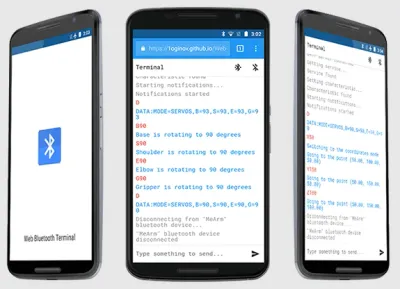
There are a few Bluetooth-related node.js libraries that provide Bluetooth related functionality:
- [bluetooth-serial-port by eelcocramer]: Provides serial port support for Bluetooth, however as of Sep 2025 it hasn’t been updated in 2 years and lists itself as being deprecated. Requires
libbluetooth-devon Linux. Requires Visual C++ and it’s command-line tools installed on Windows. Requires Python 2.x on all platforms. MacOS support was “temporarily” dropped inv3.0.0. - node-bluetooth by song940: Requires node-gyp to be installed on all platforms, and additionally
libbluetooth-devon Linux.
noble and abandonware/noble
noble provides general BLE support to node.js applications. It supports Windows, Linux, macOS, and FreeBSD.30 However, as of Sep 2025, it hasn’t been updated in 7 years! There is a fork called abandonware/noble that is more actively maintained (as of Sep 2025, last commit was 7 months ago).
Bluetooth Dongles
BleuIO
BleuIO produces a range of Bluetooth dongles specifically designed for engineering and development of Bluetooth applications.
Instead of relying on the operating system’s Bluetooth API, they provide their own API for interacting with the Bluetooth hardware. This gives the user more features and a consistent interface across different operating systems. For example, Windows only allows for one Bluetooth radio to be active at a time (via the OS Bluetooth stack).32. Just having one Bluetooth radio is not an issue if you use BleuIO since the dongles don’t utilize the Windows Bluetooth stack. The Python library Bleak let’s you specify an adapter, but this parameter is ignored on Windows. You can interface with the dongles via either AT commands (over a USB CDC serial port) or via provided Python/Javascript libraries (I presume the libraries utilize the AT commands also).
The BleuIO dongles are purchasable either from their website of through third party resellers such as DigiKey.
OS Support for Bluetooth
Windows
Windows only allows for one Bluetooth radio (adapter) to be active at a time (via the OS Bluetooth stack).32 If you have multiple Bluetooth adapters (including built-in ones or dongles) and want to switch between them manually, you typically need to enable and disable Bluetooth devices from the Device Manager. Dongles that don’t use the Windows Bluetooth stack (e.g. BleuIO) are not affected by this limitation.
Windows supports AFH (adaptive frequency hopping) for Bluetooth devices, but is disabled by default. A registry key needs to be written to first to enable AFH. This enables a “shared spectrum model” in where Windows can tell Bluetooth adapters which channels to avoid as to prevent interference with Wi-Fi.32
Windows also allows Bluetooth mouse and keyboard devices to wake up Windows from sleep (S3) or hibernate (S4) system power states. For this to work, the Bluetooth device must be self-powered.32
Footnotes
-
Wikipedia (2023, Apr 27). Bluetooth Special Interest Group. Retrieved 2023-05-24, from https://en.wikipedia.org/wiki/Bluetooth_Special_Interest_Group. ↩
-
Bluetooth SIG. About Us - Origin of the Bluetooth Name. Retrieved 2023-05-24, from https://www.bluetooth.com/about-us/bluetooth-origin/. ↩
-
Wikipedia (2021, May 16). Piconet. Retrieved 2023-05-24, from https://en.wikipedia.org/wiki/Piconet. ↩
-
Vijay K. Garg (2007). Wireless Personal Area Network — Bluetooth. Wireless Communications & Networking. Retrieved 2023-05-24, from https://www.sciencedirect.com/book/9780123735805/wireless-communications-and-networking. ↩
-
Bluetooth SIG. Part A. Logical Link Control and Adaptation Protocol Specification [specification]. Retrieved 2025-09-18, from https://www.bluetooth.com/wp-content/uploads/Files/Specification/HTML/Core-54/out/en/host/logical-link-control-and-adaptation-protocol-specification.html. ↩
-
Stack Overflow (2022, May). BLE L2CAP layer - segmentation vs fragmentation [forum post]. Retrieved 2025-09-18, from https://stackoverflow.com/questions/71504272/ble-l2cap-layer-segmentation-vs-fragmentation. ↩
-
Argenox. BLE Advertising Primer. Retrieved 2024-02-27, from https://www.argenox.com/library/bluetooth-low-energy/ble-advertising-primer/. ↩ ↩2 ↩3
-
Martin Woolley (2025, Jan 13). Bluetooth Core 5.0 Feature Enhancements. Bluetooth SIG. Retrieved 2025-08-04, from https://www.bluetooth.com/wp-content/uploads/2019/03/Bluetooth_5-FINAL.pdf. ↩ ↩2
-
Silicon Labs. Optimizing Current Consumption in Bluetooth Low Energy Devices. Retrieved 2024-04-30, from https://docs.silabs.com/bluetooth/3.2/general/system-and-performance/optimizing-current-consumption-in-bluetooth-low-energy-devices. ↩ ↩2
-
Novel Bits (2023, Oct 2). Coded PHY: Bluetooth’s Long Range Feature. Retrieved 2025-08-03, from https://novelbits.io/bluetooth-long-range-coded-phy/. ↩ ↩2 ↩3
-
Henry Anfang (2019, Dec 31). Bluetooth PHY - How it Works and How to Leverage it. Punch Through. Retrieved 2025-08-03, from https://punchthrough.com/crash-course-in-2m-bluetooth-low-energy-phy/. ↩
-
Wikipedia (2024, Jul 31). Frequency-shift keying [wiki]. Retrieved 2025-08-03, from https://en.wikipedia.org/wiki/Frequency-shift_keying. ↩
-
GitHub (2020, Mar 15). NordicSemiconductor > Android-BLE-Library > Issues > List of Coded PHY Supported/Tested Phones #166 [GitHub issue]. Retrieved 2025-08-09, from https://github.com/NordicSemiconductor/Android-BLE-Library/issues/166. ↩ ↩2 ↩3 ↩4 ↩5 ↩6 ↩7
-
Martin Woolley (2017, Aug 1). BlueTooth Blog - An Intro to Bluetooth Mesh Part 2. BlueTooth SIG. Retrieved 2023-05-24, from https://www.bluetooth.com/blog/an-intro-to-bluetooth-mesh-part2/. ↩
-
Silicon Labs. AN1137: Bluetooth Mesh Network Performance. Retrieved 2023-05-24, from https://www.silabs.com/documents/public/application-notes/an1137-bluetooth-mesh-network-performance.pdf. ↩
-
Nanjing Qinheng Microelectronics Co., Ltd. Bluetooth serial port transparent chip: CH9141. Retrieved 2024-11-20, from https://www.wch-ic.com/products/CH9141.html. ↩ ↩2
-
Cypress Semiconductor (2016, Nov 23). CYW20702 - Single-Chip Bluetooth Transceiver and Baseband Processor [datasheet]. Retrieved 2025-02-05, from https://www.alldatasheet.com/datasheet-pdf/download/902264/CYPRESS/BCM20702.html. ↩
-
Wikipedia (2024, Sep 12). CSR plc [wiki]. Retrieved 2025-02-05, from https://en.wikipedia.org/wiki/CSR_plc. ↩
-
tonymacx86 (2022, Oct 25). Tp-Link UB400 not being recognized [forum post]. Retrieved 2025-02-05, from https://www.tonymacx86.com/threads/tp-link-ub400-not-being-recognized.322815/. ↩
-
Shenzhen SHSD Technology Co.,Ltd. HC-05 Data Sheet - Bluetooth to Serial Port Module [datasheet]. Retrieved 2025-09-19, from https://cdn.awsli.com.br/945/945993/arquivos/HC-05-BOARD.pdf. ↩
-
ElectronicWings. Bluetooth Module HC-05 Pinout, AT Commands & Arduino Programming. Retrieved 2025-09-19, from https://www.electronicwings.com/sensors-modules/bluetooth-module-hc-05-. ↩
-
Bluetooth SIG (2003, Jun 5). RFCOMM with TS 07.10 Serial Port Emulation - v1.1 [specification]. Retrieved 2025-09-18, from https://www.bluetooth.com/specifications/specs/html/?src=RFCOMM_v1.1/out/en/index-en.html#UUID-d6d80781-0c47-2246-5814-6a44e22f6c27. ↩
-
Nordic Semiconductor. Nordic UART Service (NUS) [website]. Retrieved 2025-09-16, from https://docs.nordicsemi.com/bundle/ncs-latest/page/nrf/libraries/bluetooth/services/nus.html. ↩
-
Microchip (2023, Nov 9). Transparent UART service for BM70/RN4870 [website]. Retrieved 2025-09-16, from https://developerhelp.microchip.com/xwiki/bin/view/applications/ble/android-development-for-bm70rn4870/transparent-uart-service-for-bm70rn4870/. ↩
-
Texas Instruments (2015). TI Serial Port Service (SPS) - Service and characteristic description [pdf]. Retrieved 2025-09-16, from https://www.ti.com/lit/ug/tidua63/tidua63.pdf. ↩ ↩2
-
u-blox (2021, Nov 29). u-connectXpress - Bluetooth Low Energy Serial Port Service - Protocol specification [pdf]. Retrieved 2025-09-19, from https://content.u-blox.com/sites/default/files/u-connectXpress-LowEnergySerialPortService_ProtocolSpec_UBX-16011192.pdf. ↩
-
Silicon Labs. SPP (Serial Port Profile) over BLE [documentation]. Retrieved 2025-09-19, from https://docs.silabs.com/bluetooth/2.13/bluetooth-code-examples-applications/. ↩
-
Matthew Ford (2017, Nov 15). Bluetooth V4, Bluetooth V5 (BLE) Problems and Solutions for General Purpose Control [article]. Forward Computing and Control Pty. Ltd. Retrieved 2025-09-16, from https://www.forward.com.au/pfod/BLE/BLEProblems/index.html. ↩
-
loginov-rocks. loginov-rocks/Web-Bluetooth-Terminal [GitHub repository]. GitHub. Retrieved 2025-09-15, from https://github.com/loginov-rocks/Web-Bluetooth-Terminal. ↩
-
noble. noble/noble [GitHub repository]. GitHub. Retrieved 2025-09-19, from https://github.com/noble/noble. ↩
-
BlueIO. Homepage [website]. Retrieved 2025-11-11, from https://www.blueio.com/. ↩
-
Microsoft. Learn > Windows > Windows Drivers > Bluetooth FAQ. Retrieved 2025-11-14, from https://learn.microsoft.com/en-us/windows-hardware/drivers/bluetooth/bluetooth-faq. ↩ ↩2 ↩3 ↩4



